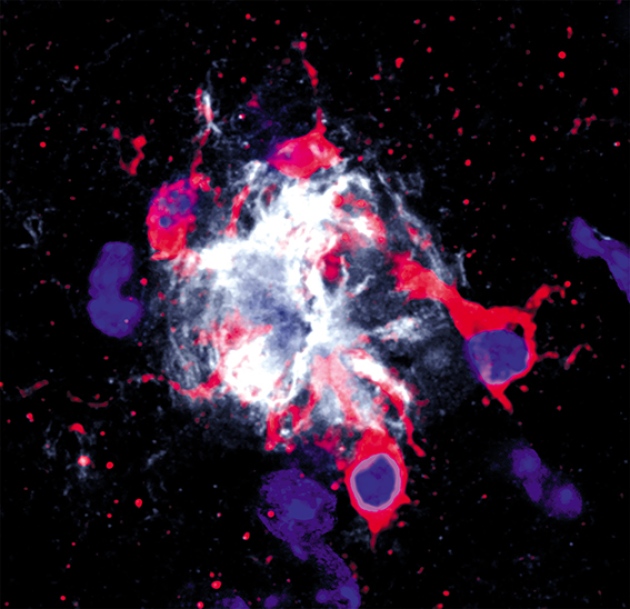via 3 Quarks Daily: Amir Giladi and Ido Amit in Nature

Single-cell genomics can identify unique immune cells (red) involved in Alzheimer's disease.
For more than a century, scientists have tried to characterize the different functions of the 10 trillion to 50 trillion cells of the human body — from neurons, which can reach 1 metre in length, to red blood cells, which are around 8 micrometres wide. Such efforts have helped to identify important cell types and pathways that are involved in human physiology and pathology. But it has become apparent that the research tools of the past few decades fail to capture the full complexity of cell diversity and function. (These tools include fluorescent tags fused to antibodies that bind to specific proteins on the surfaces of cells, known as cell-surface markers, and sequencing in bulk of the RNA or DNA of thousands of seemingly identical cells.) This failure is partly because many cells with completely different functions have similar shapes or produce the same markers. Single-cell genomics is transforming the ability of biologists to characterize cells. The new techniques that have emerged aim to capture individual cells and determine the sequences of the molecules of RNA and DNA that they contain. The shift in approach is akin to the change in how cells and molecules could be viewed during the 1980s, following advances in microscopy and the tagging and sorting of cells.
Continue reading
=============================
via Boing Boing by Rusty Blazenhoff
On Super Bowl sunday, I usually can be found bowling with friends instead of watching football. We dress up in superhero costumes and award each other silly trophies that we've created just for the occasion. We actually call it the "Super Bowl," because, well, bowling.
Continue reading
=============================
via OUP Blog by John Hutchinson

The Siege and Destruction of Jerusalem by the Romans Under the Command of Titus by David Roberts. Public Domain via Wikimedia Commons.
There are at least four ways in which warfare in its changing forms has been formative in the rise and transformation of national collectivities.
First, warfare has been central for much nation-state formation. Most nation-states that came into existence before the mid-20th century were created by war or had their boundaries defined by wars or internal violence. Charles Tilly famously wrote, ‘War makes states and states make war’ in tracing the rise of the nation state to the incessant warfare generated by the military revolutions of early modern Europe. Out of these conflicts in early modern Europe came centralized administrations, general taxation, and the control of violence over consolidated territories. The costs of war bankrupted the French state, leading to the French Revolution that, in fusing nation and state, mobilised mass loyalties with unprecedented military power. It is hardly an exaggeration to say that modern nationalism, in both its civic and ethnic varieties, crystallised in the subsequent Revolutionary and Napoleonic wars. Many nationalists subsequently have cited the willingness of populations to sacrifice themselves for the nation-state as an indicator of its validity.
Continue reading
=============================
via the Guardian by Jennifer Raff

Head and shoulders of a sculpted model of a female Neanderthal.
Photograph: Alamy
Keeping pace with new developments in the field of human evolution these days is a daunting prospect. It seems as though every few weeks there’s an announcement of exciting new findings from hominin fossils, or the recovery of an ancient genome that significantly impacts our understanding of our species’ history.
The best way to keep up is by regularly revisiting and reassessing a few core questions. When and where did our species first appear? How and where did we migrate? What was our relationship to our (now-extinct) hominin relatives? What evolutionary and cultural factors influenced our histories? How do new findings change the answers to these questions? Are they generally accepted by the relevant community of experts, or are they provisional or controversial?
Continue reading
=============================
via Boing Boing by Andrea James

Watch as an off-the-shelf Barbie gets a superhero makeover in this delightful tutorial. Includes a list of materials used and a very relaxing voiceover.
Continue reading
=============================
A stuffed history of the closet, where the “past becomes space.”
via Arts & Letters Daily: Shannon Mattern in Places Journal

Closets from the Historic American Buildings Survey: Joseph Stebbins House, Deerfield, MA; Theodate Pope-Riddle House, Farmington, CT; G. N. Wilcox House, Lihue, HI. [Library of Congress]
At the end of the hallway in my childhood home was a linen closet with a white louver door. The afternoon sun sliced through its wooden slats, illuminating the bath towels and bedsheets stacked on its shelves. I’m familiar with the intimate ambience of this space because I spent a good bit of time there, in what I called my “poetry office.” I would kick out the vacuum and open the case of my grandfather’s Smith Corona typewriter, releasing the preserved smells of his basement study: mildew and sawdust and cigar smoke. In an afternoon shift amidst the linens, I wrote dozens of poems.
I still have some of that juvenilia, mixed up with decades of birthday cards and tax returns and handwritten letters, in the closet of my current home. On the shelf above: a shoebox of 3.5″ floppy disks, mixtapes, and DVDs (which I no longer own the equipment to access). Nearby: cameras and audio recorders, external hard drives and Time Capsules, assorted devices and cables obsolesced by Apple’s ever-evolving ports and plugs.
Continue reading
=============================
via 3 Quarks Daily by Carol A Westbrook
I came across an old photo from about 1915, which had the names, "Anna, Rose, Mother" penciled on the back. The photo demonstrated that my grandmother, Anna, had a sister, Rose, which was also the name of the grandmother of a newly discovered DNA relative. We were second cousins – and a new branch of the family was discovered! I was pleased to find this old picture that had been kept for so long in a box in the attic.
How much we treasure our old family photos! They bring us our forebears, as well as old memories. But photos do more than preserve family memories. Since the beginning of civilization we have relied on permanent images to document lineage, leadership, historical events, wars, battles, and, of course, the news of the day. These relationships reinforce the foundation on which society is built.
Before photos, we had hand-painted portraits, sculptures, carvings and tomb paintings for these vital functions. These media were long lasting but not always accurate, not to mention difficult. Photography made it so much easier.
Continue reading
Unfortunately this photography post does not allow me to copy the photo of grandmother.
=============================
via OUP blog by Maya Balakirsky Katz

“Detail of East Window, All Saints, Tudeley- designed by Marc Chagall”, photographed by Tony Grist. Public Domain via Wikimedia Commons.
One hundred thirty years after the birth of Moishe Shagall, as he was known in his small Hasidic neighborhood on the outskirts of Vitebsk, and thirty-two years after the death of Marc Chagall, as he came to be known in the modern art world, we are starting to understand his vision. Somewhere in between his life dates, Chagall became the world’s preeminent Jewish artist at a time when the Russian Jewish intelligentsia fanatically directed itself towards universalism. His stained-glass windows opened onto the world from the cathedrals of Reims and Metz, the United Nations, and the Hadassah Hospital in Jerusalem. It is interesting, then, that Chagall’s radical religious vision has been subsumed under his cultural one in debates over his national identity, whether Jewish, French, or American. However his internationalism manifested itself in his practical life, Chagall’s aesthetic internationalism did not seek to disavow but to embody both God and the nation-state within the unbound, undifferentiated experience of color and light.
Continue reading
=============================
via Boing Boing by Mark Frauenfelder

I recently started to re-read God is Disappointed in You, which I read for the first time a couple of years ago. It's an amazing piece of work. Here's my original review:
I’m not religious, and I have not read the Old Testament or the New Testament (I did read R. Crumb’s graphic novel of the Book of Genesis and enjoyed it). I’ve tried to read the King James version a few times, but I got bored and stopped very early on. Recently, Top Shelf sent me a copy of God is Disappointed in You, a new version of the Bible written in contemporary, casual language. It’s bound in textured fake leather like a regular bible, with gold edged pages and a ribbon bookmark. It has illustrations by New Yorker and Too Much Coffee Man cartoonist Shannon Wheeler, which piqued my interest. As soon as I started reading it, I was hooked. The author, Mark Russell, was able to make the stories come alive by telling them as if they happened today, using language that a smart, funny, middle-school student might use to recount the story of an epic playground fight.
I don’t know if people who take the Bible seriously will be offended by this book, but I suspect many of them will not. It is not a sarcastic put down of the Bible, but a fresh interpretation. I compared some of the stories in God is Disappointed in You with the stories in other traditional Bibles and Russell is not exaggerating or misrepresenting the content of the earlier versions. I asked my friend, a pastor and author who is a serious Bible scholar, what he thought of God is Disappointed in You, and said it was fantastic.
The Bible is an incredibly weird book, and I thank Mark Russell for rewriting it in a way that made it understandable and interesting to me.
=============================
via Interesting Literature
A summary of a classic late poem
‘Crossing the Bar’ was one of Alfred, Lord Tennyson’s last poems, composed in 1889, just three years before the end of a long life and prolific career. (He would be UK Poet Laureate for 42 years in total, a record still unsurpassed.) Given its elegiac tone, ‘Crossing the Bar’ has often been analysed or interpreted as Tennyson’s elegy for himself: it describes his anticipation of the ‘crossing’ he must make from life to death.
Continue reading
No comments:
Post a Comment